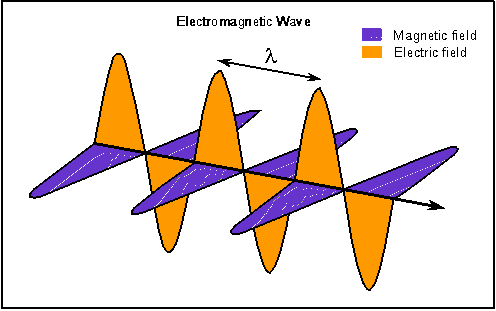
Electric and magnetic fields oscillate together but perpendicular to each other and the electromagnetic wave moves in a direction perpendicular to both of the fields.
Video lecture for this chapter
In order to understand light, you first need to have an understanding of electric fields and magnetic fields. Electrical charges and magnets alter the region of space around them so that they can exert forces on distant objects. This altered space is called a force field (or just a field). Rather than describing the action of forces by having a distant object somehow reach out across space and push or pull on a body, the body simply responds to its local environment. An electric charge or a magnet responds to the field immediately surrounding it. That field is produced by a distant object. In the same way, a massive object can produce a gravity field that distant objects will respond to.
Scientists have known since the early part of the 19th century that electrical fields and magnetic fields are intimately related to each other and applications of this connection are found all around you. Moving electric charge (electric current) creates a magnetic field. Coils of wire can be used to make the large electromagnets used in car junk yards or the tiny electromagnetics in your telephone receiver. Electric motors used to start your car or spin a computer's harddisk around are other applications of this phenomenon. In fact, ordinary magnets are produced from tiny currents at the atomic level.
A changing magnetic field creates electrical current---an electric field. This concept is used by power generators---large coils of wire are made to turn in a magnetic field (by falling water, wind, or by steam from the heating of water by burning coal or oil or the heat from nuclear reactions). The coils of wire experience a changing magnetic field and electricity is produced. Computer disks and audio and video tapes encode information in magnetic patterns of alternating magnetic directions and magnetic strengths. When the magnetic disk or tape material passes by small coils of wire, electrical currents (electric fields) are produced.
James Clerk Maxwell (lived 1831--1879) put these ideas together and proposed that if a changing magnetic field can make an electric field, then a changing electric field (from an oscillating electric charge, for example) should make a magnetic field. A consequence of this is that changing electric and magnetic fields should trigger each other and these changing fields should move at a speed equal to the speed of light. To conclude this line of reasoning, Maxwell said that light is an electromagnetic wave. Later experiments confirmed Maxwells's theory.

![]() Go back to previous section --
Go back to previous section --
![]() Go to next section
Go to next section
last updated: 17 May 2001